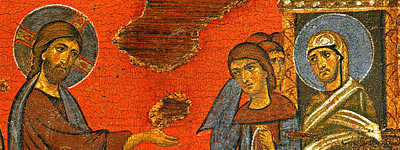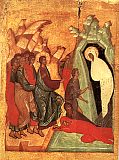

| Previous day | Next day |
| Old Style
March 26
|
Saturday |
New Style
April 8
|
|
Sixth Week of Great Lent (Palm Week). Lazarus Saturday.
Tone 1.
Great Lent. Caviar, wine and oil allowed. |
Caviar, wine and oil allowed.
|
![]() Lazarus Saturday
Lazarus Saturday ![]() Synaxis of the Archangel Gabriel.
Synaxis of the Archangel Gabriel.
![]() Hieromartyr Irenaeus, bishop of Sirmium (304).
Hieromartyr Irenaeus, bishop of Sirmium (304). ![]() Hieromartyrs Bathusius and Bercus, priests, Monk-martyr Arpilus, and Martyrs Abibus, Agnus, Reasus, Igathrax, Iscoeus (Iskous, Escoes), Silas, Signicus, Sonerilas, Suimbalus, Thermus, Phillus (Philgas), Anna, Alla, Larissa, Monco (Manca), Mamica, Uirko (Virko), Animais (Animaida), Gaatha the queen of the Goths, and Duklida, in the Crimea (ca. 375). St. Malchus of Chalcis in Syria (4th c.). St. Basil the Younger, anchorite, near Constantinople (10th c.).
Hieromartyrs Bathusius and Bercus, priests, Monk-martyr Arpilus, and Martyrs Abibus, Agnus, Reasus, Igathrax, Iscoeus (Iskous, Escoes), Silas, Signicus, Sonerilas, Suimbalus, Thermus, Phillus (Philgas), Anna, Alla, Larissa, Monco (Manca), Mamica, Uirko (Virko), Animais (Animaida), Gaatha the queen of the Goths, and Duklida, in the Crimea (ca. 375). St. Malchus of Chalcis in Syria (4th c.). St. Basil the Younger, anchorite, near Constantinople (10th c.).
Martyr Codratus (Quadratus), and with him 40 Martyrs, who suffered under Diocletian (284-305). Hieromartyr Eusebius, bishop of Kival, and Martyr Pullius the Reader. Hieromartyr Montanus, priest, and his wife Maxima, at Sirmium (ca. 304). St. Eutychius, subdeacon, of Alexandria (356). St. Braulio of Saragossa in Iberia (646). St. Ludger, bishop of Munster and missionary to northwestern Germany (809). New Martyr George of Sofia, at Adrianople (1437). St. Stephen the Confessor and Wonderworker, abbot, of Tryglia (815).
Thoughts for Each Day of the Year
According to the Daily Church Readings from the Word of God
By St. Theophan the Recluse

Saturday. [Heb. 12:28–13:8; John 11:1–45]
To whomever has work-loving Martha, who symbolizes comprehensive good works, and who has Mary sitting at Jesus’ feet, symbolizing an attentive and warm appeal to the Lord with all the heart, the Lord Himself will come and will resurrect Lazarus, who symbolizes his spirit, and will release him from all his emotional and fleshly bonds. Then a truly new life will begin in him, bodiless in the body and unearthly on the earth. It will be a true resurrection in the spirit before the future resurrection, which will be together with the body!
Articles
 Lazarus Saturday |
 Hieromartyr Irenaeus the Bishop of SirmiumHieromartyr Irenaeus suffered during the persecution against Christians under the Roman emperors Diocletian and Maximian (284-305). |
 Saint Malchus of Chalcis in SyriaSaint Malchus was the only son of a farmer, and lived near Antioch, Syria. |
 Venerable Basil the New, Anchorite, Near ConstantinopleSaint Basil the New left the world in his youth, and struggled in a desolate place. |



